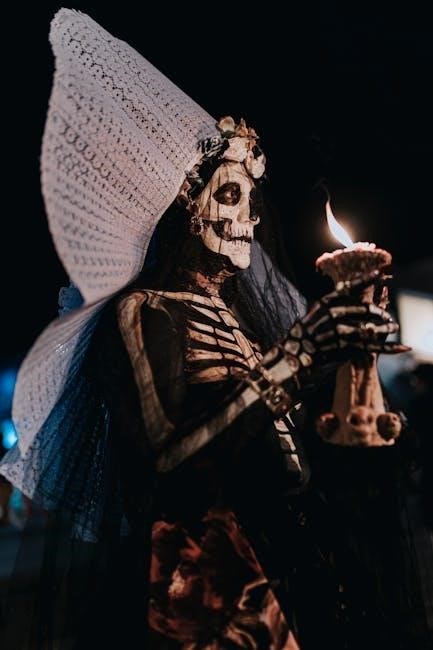Mexican spirit guides, like alebrijes, embody the essence of nature, culture, and spirituality, serving as symbolic companions rooted in indigenous traditions and the vibrant heritage of Mexico.
Overview of Mexican Spirit Guides
Mexican spirit guides, deeply rooted in indigenous cultures, are symbolic beings that embody the connection between the natural and spiritual worlds. These guides, such as alebrijes, are often depicted as intricate, fantastical creatures crafted from wood or paper, blending elements of various animals. Originating from the Zapotec and Mixtec traditions, they represent the harmony between humans and nature. Spirit guides are believed to offer protection, wisdom, and guidance, serving as companions on life’s journey. They are integral to Mexican folklore, often appearing in art, rituals, and daily life. Their significance extends beyond spirituality, influencing cultural practices and artistic expressions, making them a cherished part of Mexico’s heritage.

Historical Background of Spirit Guides in Mexico
Mexican spirit guides trace their origins to ancient indigenous cultures, such as the Zapotec and Mixtec, where spirituality and nature were deeply intertwined. These guides were believed to embody the essence of ancestors, animals, and deities, serving as intermediaries between the physical and spiritual realms. The Nahua people, including the Aztecs, revered spirit guides as manifestations of divine power, often associating them with deities like Quetzalcoatl. Over centuries, these beliefs evolved, blending with Catholicism during the colonial period, leading to syncretic practices. Today, spirit guides remain integral to Mexican identity, featured in folklore, art, and rituals, symbolizing resilience and cultural continuity. Their historical roots highlight the enduring connection between Mexico’s past and its spiritual traditions.

Definition and Role of Spirit Guides
Spirit guides are spiritual beings believed to offer wisdom, protection, and guidance, originating from Mexico’s indigenous traditions and playing a vital role in personal growth and cultural identity.
What Are Spirit Guides?
Spirit guides are believed to be supernatural beings or symbolic figures that provide guidance, wisdom, and protection. In Mexican culture, they often take the form of alebrijes, colorful animal figurines representing spiritual companions. These guides are thought to embody the essence of nature and ancestors, offering insight and healing. Originating from indigenous traditions, spirit guides are seen as messengers between the physical and spiritual worlds. They are believed to assist individuals in navigating life’s challenges, fostering personal growth, and maintaining balance. Through rituals and meditation, people connect with these guides, seeking their influence for clarity and strength. Spirit guides are deeply rooted in Mexico’s rich cultural heritage, symbolizing a connection to the divine and the natural world, and are often celebrated in art, folklore, and daily life.
The Role of Spirit Guides in Daily Life
Spirit guides play a vital role in daily life by offering emotional, spiritual, and psychological support. They are believed to provide wisdom, protection, and guidance, helping individuals navigate life’s challenges. In Mexican culture, spirit guides like alebrijes are often seen as companions that inspire creativity, resilience, and positivity. They are integrated into daily rituals, prayers, and meditations, serving as a source of comfort and strength. Many people believe these guides help them make decisions, overcome fears, and find purpose. By connecting with spirit guides, individuals can foster a deeper sense of balance and harmony in their lives. This connection is often reinforced through traditions, art, and storytelling, making spirit guides an integral part of daily existence and cultural identity in Mexico.

Types of Mexican Spirit Guides
Mexican spirit guides include alebrijes, ancestral spirits, nature spirits, and deities, each embodying unique qualities and roles in spirituality and cultural practices, offering wisdom and protection.

Ancestral Spirits
Ancestral spirits hold a revered place in Mexican spirituality, believed to serve as protectors and guides, offering wisdom and healing. These spirits are thought to embody the collective knowledge and experiences of one’s ancestors, acting as intermediaries between the living and the divine. Rooted in indigenous traditions, ancestral spirits are often honored during rituals like the Day of the Dead, where families pay tribute to their deceased loved ones. The Zapotec calendar, for instance, highlights a 20-day cycle dedicated to ancestor worship. Ancestral spirits are believed to provide guidance in times of uncertainty, influencing decisions and fostering a deep connection to cultural heritage. Their presence is felt in daily life, reinforcing values of respect, resilience, and unity with the past.
Nature Spirits and Their Significance
Nature spirits in Mexican culture are deeply intertwined with the land and its elements, embodying the essence of animals, plants, and natural phenomena. These spirits are believed to carry the wisdom of the earth, offering guidance to those seeking balance and harmony in life. Often depicted in symbolic art forms like alebrijes, nature spirits are thought to serve as messengers between humans and the natural world. They are associated with qualities like resilience, adaptability, and renewal, inspiring individuals to live in sync with the environment. In spiritual practices, nature spirits are invoked through rituals and meditation to foster healing and clarity. Their significance lies in their role as protectors of the land and guides for those seeking to understand their place within the larger web of life.
Deities and Their Influence
Deities in Mexican spirituality serve as powerful spirit guides, embodying cosmic forces and moral principles. Figures like Quetzalcoatl, Huitzilopochtli, and Coatlicue are revered for their wisdom and influence over human destiny. These deities are believed to offer guidance in matters of morality, strength, and wisdom, acting as higher spirit guides who connect individuals to the divine. Their stories and attributes, deeply rooted in Mexican mythology, inspire followers to embrace virtues like courage and resilience. Rituals and ceremonies often honor these deities, seeking their protection and blessings. Their influence extends beyond spirituality, shaping art, folklore, and cultural identity. By invoking these deities, people seek to align their lives with universal truths and achieve harmony in their journeys. Their enduring presence reflects the profound respect for ancestral wisdom in Mexican traditions.

Cultural Significance of Spirit Guides
Mexican spirit guides, such as alebrijes, hold deep cultural significance, inspiring art, traditions, and spiritual practices that connect individuals to their heritage and promote inner growth and harmony.
Impact on Art and Folklore
Mexican spirit guides, such as alebrijes, have profoundly influenced the country’s artistic and cultural narratives. These vibrant, handcrafted figurines, often depicting fantastical animals, symbolize the fusion of indigenous traditions and modern creativity. Originating from Zapotec mythology, alebrijes have evolved into iconic representations of Mexico’s spiritual connection to nature and the supernatural. They inspire artists, filmmakers, and writers, becoming central motifs in murals, literature, and even contemporary digital media. In folklore, spirit guides are often depicted as protectors and messengers, appearing in stories and rituals to guide individuals through life’s challenges. Their presence in festivals, such as the Day of the Dead, further cements their cultural significance, blending artistry with spiritual practices. This interplay of art and folklore ensures that Mexican spirit guides remain a vital part of the nation’s identity and creative expression.

Traditions and Rituals Involving Spirit Guides
Mexican traditions often incorporate spirit guides through rituals that honor ancestral connections and nature. A key practice is the creation of altars during the Day of the Dead, where offerings are made to guide spirits back to the living. These altars, adorned with flowers, candles, and photographs, symbolize the belief that spirits return to offer wisdom and protection. Additionally, rituals like meditation and prayer are used to communicate with spirit guides, seeking guidance and healing. The crafting of alebrijes, symbolic animal figurines, is another tradition, believed to embody spirit guides that watch over individuals. These rituals strengthen the bond between the physical and spiritual worlds, reflecting Mexico’s deep-rooted spirituality and respect for the unseen.
Community Beliefs and Spirituality

Mexican communities deeply believe in the interconnectedness of the spiritual and physical worlds. Spirit guides, such as alebrijes, are seen as protectors and wisdom-bearers, embodying the essence of nature and cultural heritage. These beliefs are often passed down through generations, fostering a sense of unity and shared identity. Rituals like the Day of the Dead highlight the reverence for ancestors, who are believed to guide the living. Spirituality is woven into daily life, with practices such as meditation and prayer serving as bridges to the spiritual realm. The belief in spirit guides offers comfort, guidance, and a deeper understanding of life’s journey, reinforcing moral and ethical values within the community.
Connecting with Spirit Guides
Connecting with Mexican spirit guides involves meditation, rituals, and introspection, helping individuals understand their life’s path and fostering harmony with nature and cultural spirituality.
Meditation and Ritual Practices
Meditation and rituals are central to connecting with Mexican spirit guides. Practices often involve focused breathing, visualization of symbolic imagery, and the use of traditional elements like copal incense and drum rhythms. These rituals create a sacred space for individuals to communicate with their guides, fostering a deep connection with ancestral wisdom and nature spirits. Many also incorporate the use of Alebrijes, which are believed to represent spirit animals, guiding individuals on their spiritual journeys. Through these practices, individuals seek balance, clarity, and guidance, aligning themselves with the spiritual energies that embody Mexico’s rich cultural heritage.

Modern Practices and Their Benefits

Modern practices involving Mexican spirit guides blend traditional rituals with contemporary methods, offering individuals a unique way to connect with their spiritual essence. Many now incorporate meditation apps and virtual workshops to honor ancestral traditions while adapting to modern lifestyles. The use of Alebrijes, symbolic animal figurines, has gained popularity as tools for self-discovery and introspection. These practices foster emotional balance, clarity, and a renewed sense of purpose. By integrating spirit guides into daily life, individuals often experience heightened intuition and resilience. The communal aspect of these practices strengthens cultural ties, creating a bridge between past and present. This fusion of old and new allows people to embrace their spiritual heritage in meaningful and accessible ways, enriching their lives with the wisdom and vibrancy of Mexico’s rich traditions.

